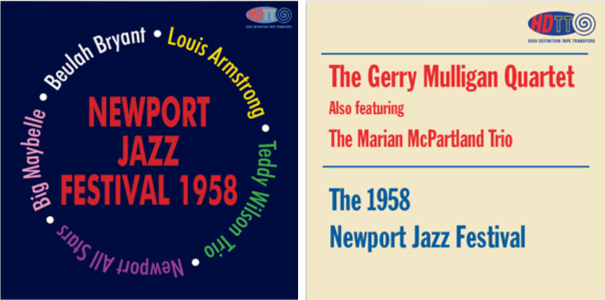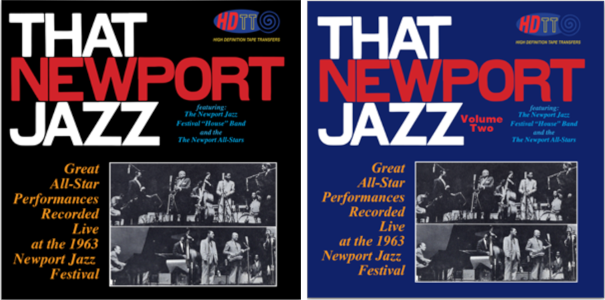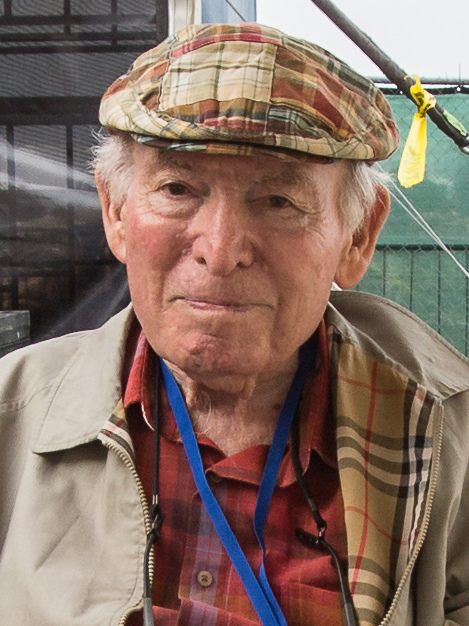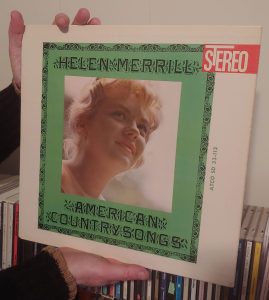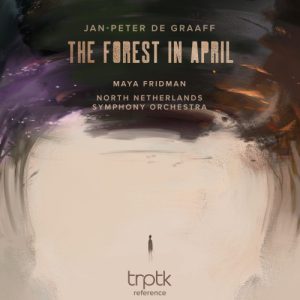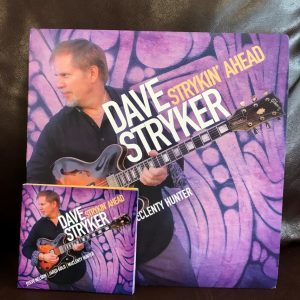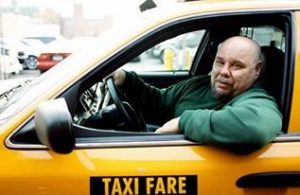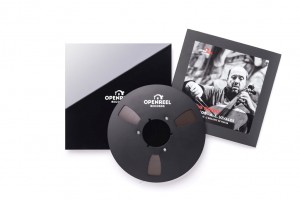Live recordings from the 1958 and 1963 Newport Jazz Festivals are legendary. Other years are also amazing, but its 1958 and 1963 in which I've been living recently. Louis Armstrong, Teddy Wilson, Marian McPartland, Gerry Mulligan, Art Farmer, Coleman Hawkins, Clark Terry—oh, my! And in high resolution. This is sinful goodness, and I'm just loving it.
The 1958 Newport Jazz Festival, Gerry Mulligan Quartet also featuring The Marian McPartland Trio. HDTT. 1958, 2021 (DSD256 PureDSD) HERE
Newport Jazz Festival 1958, Louis Armstrong, Teddy Wilson Trio, Big Maybelle, Beulah Bryant. HDTT. 1958, 2021 (DXD) HERE
First, a general caution: Keep in mind that these are live recordings. That's part of the energy. It's also part of the reason these will not be as controlled sonically as a studio recording. Placement of the microphones, and the mix, are usually good, but there will be some errant sections on any of these four recordings. The tape is what the tape is. But the transfers by HDTT are clean and clear, particularly the PureDSD transfers.
Second caution: These files don’t include any of the Miles Davis, Duke Ellington, Dave Brubeck, Mahalia Jackson, Thelonious Monk, McCoy Tyner, Herbie Mann, or John Coltrane performances from the 1958 or 1963 Festivals. But don't let that stop you. There's great music here.
Kick things off with Gerry Mulligan and Marian McPartland at the 1958 Newport Jazz Festival. Listen both as they play in their respective quartet and trio groups and as they cross over to play together. Just good vibes all around. When Gerry Mulligan launched "C Jam Blues" with those low notes on his baritone saxophone, fun chills ran up my arms. Then McPartland joins him on piano and away goes the group. For me a special treat was hearing Eric Dolphy playing flute on Track 6 "I'm In Love With A Wonderful Guy," with Chico Hamilton on drums (neither are credited in the HDTT liner notes, so a very nice surprise). Throughout, Art Farmer's trumpet provides great accents and solos, nicely highlighted on Track 7 "Blueport" written by Art Farmer for the occasion since they were playing on Blues Night.
Yes, good stuff here as the band members extemporize on the various tracks. Just great live jazz.
Staying with the 1958 Festival, the next album contains more music from Blues Night, with Louis Armstrong kicking off with "On the Sunny Side of the Street". The trumpet lead in this opening track is so inimitably Armstrong's phrasing, there is no doubt about whose trumpet is taking the lead from the big band intro. And then there's that pause, Armstrong's gravelly voice comes forth, and happiness shines all around. What a treat it must have been to be in that audience on that evening. Unfortunately, this one cut is all that we hear of Armstrong on this album.
Following the opening track, we have several pieces by Teddy Wilson Trio, and then Big Maybelle and Beulah Bryant singing with The Blues Band. And these women are a treat to hear—both deliver a style of blues shouting not heard anymore.
Big Maybelle (left, 1956) and Beulah Bryant (right, Newport Jazz Festival at Avery Fisher Hall in 1980), Creative Commons
Mabel Louise Smith (1924-1972), known professionally as Big Maybelle, was an American R&B singer. Big Maybelle sang gospel as a child; by her teens, she had switched to rhythm and blues. In 2011, she was inducted to the Blues Hall of Fame. In 1955, she recorded the song "Whole Lotta Shakin' Goin' On" a full two years before Jerry Lee Lewis version. (Interestingly, it is this song that concludes the album, but sung by Beulah Bryant.)
Beulah Bryant (1918-1988) was born in Alabama but left the state as a teenager, relocating to California in 1936 and more or less officially launching her professional career about a decade later by winning an amateur contest held by a network radio show. This victory inspired her to start up her own trio, which worked regularly in California. In the mid-'40s she moved to New York and made some excellent recordings. Bryant's style was that of the so-called "blues shouters"—a style that developed during live performances without microphone where the singer had to shout to be heard over the band. She had a strong, authoritative delivery, a sense of rhythm that was like a bass drum pedal come to life. Up through the '70s, she kept busy performing in radio, films, and television, as well as keeping up a tireless schedule of personal appearances. She also maintained an exhaustive touring schedule. You will hear the show host explaining to the crowd at the end of her set that she has a plane to catch and must go.
That Newport Jazz 1963, Coleman Hawkins, Clark Terry, Howard McGee, et al. HDTT. 1963, 2016 (DXD) HERE
That Newport Jazz 1963 Volume 2, Coleman Hawkins, Zoot Sims, Clark Terry, Roy Haynes, et al. HDTT. 1963, 2021 (DSD256 PureDSD) HERE
Oh, yes, That Newport Jazz 1963 Volumes 1 and 2 have just delicious scoops of Coleman Hawkins and Clark Terry. Not to discount Zoot Simms, Roy Haines and the rest of the band members whom we get to enjoy on this album. I'll take this all day, any day, that I can hear it with this wonderful live performance energy in such great sound quality.
Multiple tracks are performed by the Newport All Stars, a group led by festival organizer and pianist George Wein. Originally a swing Dixie group, the Newport All-Stars had been in existence since 1956 with numerous talented musicians cycling on and off the roster. For the 1963 Festival, the roster included: Roy Haynes, Al Gray, Lionel Marshall, Bud Freeman. Not shabby, not shabby at all.
From the liner notes:
In 1954, when George Wein presented the first Newport Jazz Festival, 11,000 people showed up to the Newport Casino to hear Billie Holiday, Dizzy Gillespie, and Ella Fitzgerald, among others.
In the years immediately following, Wein attempted to continue the festival despite having difficulty finding a venue. The Newport Casino could not hold such a large event, and many affluent Newport residents opposed the festival, as it tended to attract rowdy youngsters. Racism also stood as an obstacle, and the fact that the festival brought African-American audiences to a predominantly white town was the cause of some grumbling.
The Festival continued, and as the crowds grew, so did the risk of problems. In 1960, the National Guard had to be summoned to calm a disruptive group of audience members. Afterwards, it seemed that the festival would no longer exist.
Although no festival was staged in 1961, Wein brought it back the following year. The festival continued to grow throughout the 1960s, and in an attempt to attract a new generation of young people, also began incorporating popular acts that strayed from the traditional jazz programming. In 1969, the lineup included Blood, Sweat, and Tears, Jethro Tull, Sly and the Family Stone, and James Brown.
Newport, RI - August 1: Newport Jazz Festival founder and Newport Folk Festival co-founder George Wein, behind the Fort Stage at the Newport Jazz Festival. Shot on Friday, August 1, 2014.
George Wein (1925-2021) was the founder of the Newport Jazz Festival, co-founder of the Newport Folk Festival with Pete Seeger and Theodore Bikel, and instrumental in the founding of the New Orleans Jazz and Heritage Festival. Among many awards Wein received over his life, he was been honored at the White House by two American presidents, Jimmy Carter in 1978 and Bill Clinton in 1993; in 2005, he was named a "Jazz Master" by the National Endowment for the Arts; and was decorated with France's Légion d'honneur and appointed a Commandeur de L'Ordre des Arts et Lettres (Commander of the Order of Arts and Literature) by the French government; and was a lifetime Honorary Trustee of Carnegie Hall.
All photos Creative Commons




